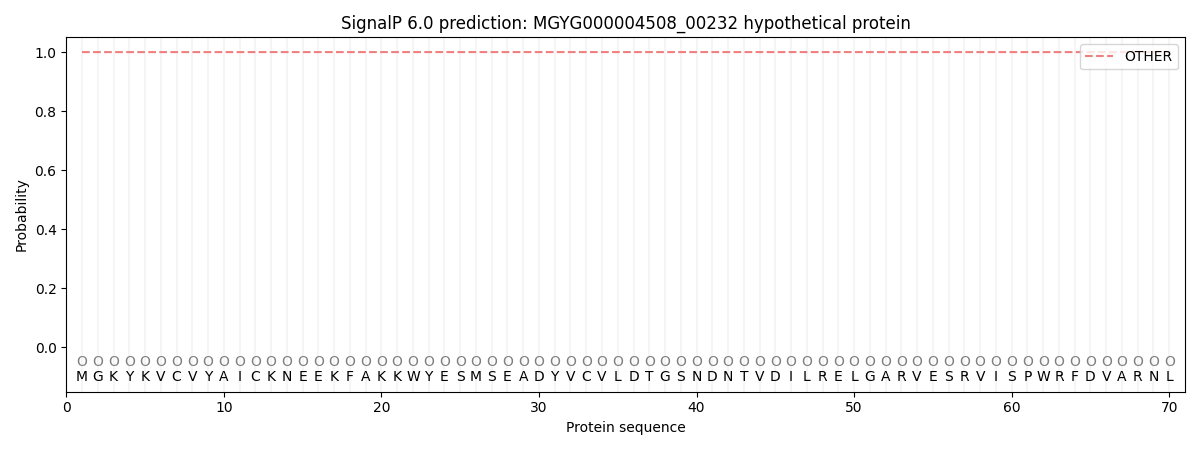You are browsing environment: HUMAN GUT
CAZyme Information: MGYG000004508_00232
You are here: Home > Sequence: MGYG000004508_00232
Basic Information |
Genomic context |
Full Sequence |
Enzyme annotations |
CAZy signature domains |
CDD domains |
CAZyme hits |
PDB hits |
Swiss-Prot hits |
SignalP and Lipop annotations |
TMHMM annotations
Basic Information help
| Species | UMGS2068 sp900769635 | |||||||||||
|---|---|---|---|---|---|---|---|---|---|---|---|---|
| Lineage | Bacteria; Firmicutes; Bacilli; RF39; UBA660; UMGS2068; UMGS2068 sp900769635 | |||||||||||
| CAZyme ID | MGYG000004508_00232 | |||||||||||
| CAZy Family | GT2 | |||||||||||
| CAZyme Description | hypothetical protein | |||||||||||
| CAZyme Property |
|
|||||||||||
| Genome Property |
|
|||||||||||
| Gene Location | Start: 45061; End: 46146 Strand: + | |||||||||||
Full Sequence Download help
| MGKYKVCVYA ICKNEEKFAK KWYESMSEAD YVCVLDTGSN DNTVDILREL GARVESRVIS | 60 |
| PWRFDVARNL SMELIPDDTD ICVCTDLDEV FNVGWREILE EKWETNACRV LYNYNWSLDE | 120 |
| DSRPIINFYL NNIHKRDDYV WIHPVHEVLT YMGDDEVVIT VPEICLNHYP DREKSRGSYL | 180 |
| PLLEMSVEED PLDDRNMHYL GREYMYYGKW NDAIDVLTRH LGLESAKWKD ERCASMRFIG | 240 |
| RCYGALKRYD EARLWYDRAI IEAPYLRDGY IEYGIFEYDR GNYEKAIWLF MRGLFRKRDY | 300 |
| KSYINEAFCR DGVICDYISM CLWYLGDYDG ALYFVDRALR DNPNDERLLD NRKIFSNMIE | 360 |
| E | 361 |
CDD Domains download full data without filtering help
| Cdd ID | Domain | E-Value | qStart | qEnd | sStart | sEnd | Domain Description |
|---|---|---|---|---|---|---|---|
| sd00006 | TPR | 3.31e-09 | 197 | 294 | 4 | 96 | Tetratricopeptide repeat. The Tetratricopeptide repeat (TPR) typically contains 34 amino acids and is found in a variety of organisms including bacteria, cyanobacteria, yeast, fungi, plants, and humans. It is present in a variety of proteins including those involved in chaperone, cell-cycle, transcription, and protein transport complexes. The number of TPR motifs varies among proteins. Those containing 5-6 tandem repeats generate a right-handed helical structure with an amphipathic channel that is thought to accommodate an alpha-helix of a target protein. It has been proposed that TPR proteins preferentially interact with WD-40 repeat proteins, but in many instances several TPR-proteins seem to aggregate to multi-protein complexes. |
| cd02511 | Beta4Glucosyltransferase | 1.32e-08 | 5 | 170 | 1 | 165 | UDP-glucose LOS-beta-1,4 glucosyltransferase is required for biosynthesis of lipooligosaccharide. UDP-glucose: lipooligosaccharide (LOS) beta-1-4-glucosyltransferase catalyzes the addition of the first residue, glucose, of the lacto-N-neotetrase structure to HepI of the LOS inner core. LOS is the major constituent of the outer leaflet of the outer membrane of gram-positive bacteria. It consists of a short oligosaccharide chain of variable composition (alpha chain) attached to a branched inner core which is lined in turn to lipid A. Beta 1,4 glucosyltransferase is required to attach the alpha chain to the inner core. |
| sd00006 | TPR | 2.55e-07 | 239 | 340 | 7 | 97 | Tetratricopeptide repeat. The Tetratricopeptide repeat (TPR) typically contains 34 amino acids and is found in a variety of organisms including bacteria, cyanobacteria, yeast, fungi, plants, and humans. It is present in a variety of proteins including those involved in chaperone, cell-cycle, transcription, and protein transport complexes. The number of TPR motifs varies among proteins. Those containing 5-6 tandem repeats generate a right-handed helical structure with an amphipathic channel that is thought to accommodate an alpha-helix of a target protein. It has been proposed that TPR proteins preferentially interact with WD-40 repeat proteins, but in many instances several TPR-proteins seem to aggregate to multi-protein complexes. |
| sd00006 | TPR | 5.18e-05 | 270 | 352 | 4 | 75 | Tetratricopeptide repeat. The Tetratricopeptide repeat (TPR) typically contains 34 amino acids and is found in a variety of organisms including bacteria, cyanobacteria, yeast, fungi, plants, and humans. It is present in a variety of proteins including those involved in chaperone, cell-cycle, transcription, and protein transport complexes. The number of TPR motifs varies among proteins. Those containing 5-6 tandem repeats generate a right-handed helical structure with an amphipathic channel that is thought to accommodate an alpha-helix of a target protein. It has been proposed that TPR proteins preferentially interact with WD-40 repeat proteins, but in many instances several TPR-proteins seem to aggregate to multi-protein complexes. |
| pfam00535 | Glycos_transf_2 | 1.36e-04 | 7 | 146 | 1 | 150 | Glycosyl transferase family 2. Diverse family, transferring sugar from UDP-glucose, UDP-N-acetyl- galactosamine, GDP-mannose or CDP-abequose, to a range of substrates including cellulose, dolichol phosphate and teichoic acids. |
CAZyme Hits help
| Hit ID | E-Value | Query Start | Query End | Hit Start | Hit End |
|---|---|---|---|---|---|
| ACV63878.1 | 1.35e-118 | 1 | 358 | 1 | 358 |
| AQS58818.1 | 9.14e-117 | 1 | 355 | 1 | 356 |
| QAT50106.1 | 3.86e-116 | 1 | 361 | 1 | 362 |
| QNK42027.1 | 6.36e-116 | 1 | 361 | 1 | 362 |
| QOX65321.1 | 2.03e-115 | 1 | 361 | 1 | 362 |
SignalP and Lipop Annotations help
This protein is predicted as OTHER

| Other | SP_Sec_SPI | LIPO_Sec_SPII | TAT_Tat_SPI | TATLIP_Sec_SPII | PILIN_Sec_SPIII |
|---|---|---|---|---|---|
| 1.000060 | 0.000000 | 0.000000 | 0.000000 | 0.000000 | 0.000000 |
